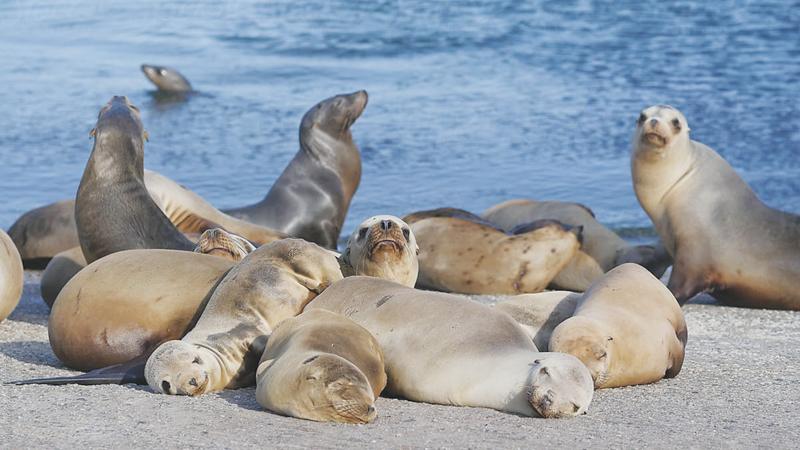
Seals and sea lions are both pinnipeds, meaning they are fin-footed marine animals, but here’s how they differ: seals generally have stubby, thinly webbed flippers for their front feet, with a claw on each small toe, compared to the larger, skin-covered flippers of sea lions.
Seals are generally smaller and better adapted to the water than land while sea lions can “walk.” Seals lack external ears, while sea lions have small flaps.
Sea Lions
Sea lions are sea mammals characterised by external ear flaps, long foreflippers, the ability to walk on all fours, and short, thick hair. Together with the fur seals, they comprise the family Otariidae, eared seals, which contains six extant and one extinct species (the Japanese sea lion) in five genera.
Their range extends from the subarctic to tropical waters of the global ocean in both the Northern and Southern Hemispheres, with the notable exception of the northern Atlantic Ocean.
They have an average lifespan of 20-30 years. A male California sea lion weighs on average about 300 kg and is about 8 ft long, while the female sea lion weighs 100 kg and is 6 ft long. The largest sea lion is Steller sea lion, which can weigh 1,000 kg and grow to a length of 10 ft.
Sea lions consume large quantities of food at a time and are known to eat about 5-8% of their body weight (about 15-35 lb) at a single feeding.
All sea lions have certain features in common, in particular their coarse, short fur, greater bulk, and larger prey than fur seals.
Some species of sea lions are readily trainable and are often a popular attraction at zoos and aquariums.
Seals
Seals are a widely distributed and diverse clade of fin-footed, semiaquatic marine mammals. They comprise the extant families Odobenidae (whose only living member is the walrus), Otariidae (the eared seals: sea lions and fur seals), and Phocidae (the earless, or true seals). There are 33 extant species of pinnipeds, and more than 50 extinct species have been described from fossils.
Seals range in size from the 1 m and 45 kg Baikal seal to the 5 m and 3,200 kg southern elephant seal, which is also the largest carnivoran. Several species exhibit sexual dimorphism. They have streamlined bodies and four limbs that are modified into flippers. Though not as fast in the water as dolphins, seals are more flexible and agile. Otariids use their front limbs primarily to propel themselves through the water, while phocids and walruses use their hind limbs. Seals have streamlined, spindle-shaped bodies with reduced or non-existent external ear flaps, rounded heads, flexible necks, limbs modified into flippers, and small tails.
Seal's skulls have large eye orbits, short snouts and a constricted interorbital region. They are unique among carnivorans in that their orbital walls are significantly shaped by the maxilla and are not limited by certain facial bones.
Compared to other carnivorans, their teeth tend to be fewer in number, are pointed and cone-shaped, and lack carnassials. (Internet)

